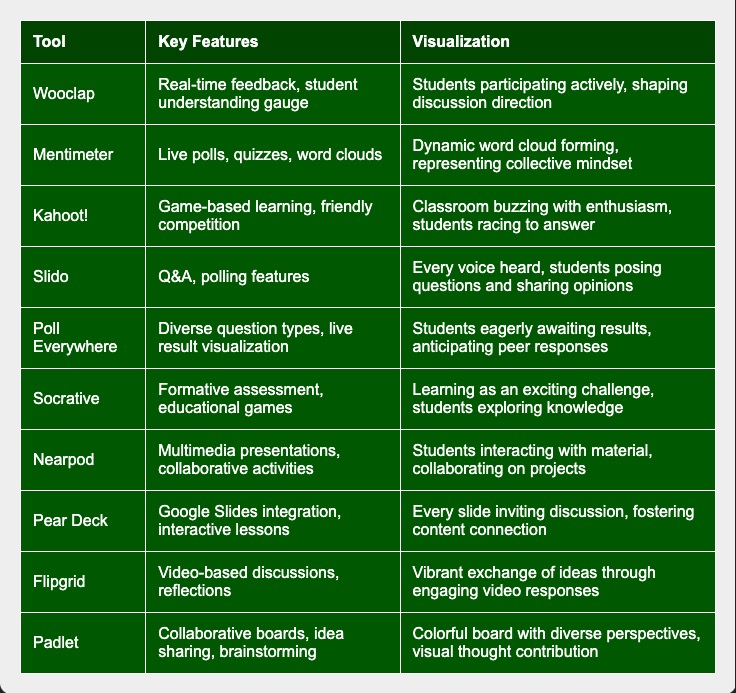Enhancing Virtual Education: A Comprehensive Approach to Interactive Learning
In today’s digital age, virtual education has progressed significantly beyond simple video lectures and static content delivery. The shift from traditional teaching methods to dynamic, collaborative environments is essential for effective online learning. This transformation is supported by a rich ecosystem of educational technology platforms and pedagogical strategies, which work together to create engaging learning experiences.
Educational technology has revolutionized our approach to teaching and learning, offering a variety of tools that cater to the diverse needs of modern pedagogy. These platforms enable educators to implement comprehensive continuous engagement and assessment strategies, combining real-time interaction with structured learning activities.
At the core of effective virtual teaching is a systematic approach to student engagement and assessment. Educators can employ continuous formative assessment through real-time polls and interactive quizzes, allowing them to gauge student understanding instantly and adjust their teaching accordingly. This immediate feedback loop fosters a more responsive and adaptive learning environment.
Participation and engagement are further enhanced through collaborative tools that transform traditional classroom dynamics. Word clouds provide visual representations of collective thinking, while live Q&A sessions create opportunities for meaningful dialogue and immediate clarification of doubts. These interactive elements help maintain student attention and create a more dynamic learning atmosphere.
The success of virtual education heavily relies on effective two-way communication. Educators can gather valuable feedback on teaching methodologies and course content through structured dialogue spaces and efficient consultation channels. This information is crucial for the continuous improvement of the learning experience.
To maximize the effectiveness of these approaches, educators can utilize various specialized platforms:
Interactive Platforms
By strategically implementing these interactive platforms, educators can significantly enhance student engagement, promote active learning, and create a more dynamic online learning environment. These tools not only facilitate real-time interaction but also provide valuable insights into student understanding and participation, allowing for more informed and adaptive teaching approaches.
Consider implementing a variety of vibrant platforms that transform traditional teaching methods into interactive adventures:
- Wooclap breathes life into presentations by enabling real-time feedback, allowing educators to gauge student understanding on the fly. As they present, students actively participate, shaping the discussion with their responses.
- Mentimeter adds excitement with live polls, quizzes, and word clouds. Students contribute their thoughts in real time, watching a dynamic word cloud form, visually representing the collective mindset of the group.
- Kahoot! turns learning into a game, where quizzes spark friendly competition and lively discussions. The classroom is enthusiastic as students race to answer questions, celebrating each victory together.
- Slido enhances meetings and events with seamless Q&A and polling features, ensuring every voice is heard. Students pose questions and share opinions effortlessly, enriching dialogue and deepening understanding.
- Poll Everywhere supports diverse question types, allowing for live result visualizations that keep everyone engaged. Students eagerly await results, curious about their peers’ responses to thought-provoking questions.
- Socrative elevates formative assessment through engaging educational games and exercises, making learning feel like an exciting challenge rather than a chore.
- Nearpod combines multimedia presentations with collaborative activities, creating a rich tapestry of learning experiences. Students interact with the material in real-time, collaborating on projects that bridge theory and practice seamlessly.
- Pear Deck integrates with Google Slides, transforming ordinary presentations into interactive sessions where students actively participate. Each slide invites discussion, fostering a deeper connection with the content.
- Flipgrid facilitates video-based discussions and reflections, allowing students to express their thoughts creatively. This vibrant exchange of ideas builds a sense of community.
- Padlet creates collaborative boards for idea sharing and brainstorming, offering a digital canvas for creativity. A colorful board filled with diverse perspectives inspires collaboration and innovation.
By harnessing these interactive platforms, educators can create a dynamic, engaging, and responsive learning environment that captivates students and transforms the educational experience.
Summary of Tools
The following table presents a selection of the aforementioned educational tools, highlighting their names, key features, and applications. These solutions enhance classroom engagement and foster interactive learning experiences, demonstrating how technology can transform traditional teaching methods into dynamic and collaborative environments.

By implementing these tools and strategies systematically, educators can:
- Maintain consistently high levels of student engagement
- Personalize learning experiences to meet individual needs
- Monitor and analyze student progress effectively
- Create more inclusive and participatory learning environments
- Adapt content and methods based on real-time feedback
These platforms can be used for:
- Real-time polls to gauge understanding or opinions
- Interactive quizzes to reinforce learning and assess comprehension
- Instant feedback collection on course content or teaching methods
- Word clouds to visualize collective thoughts on a topic
- Live Q&A sessions to efficiently address student queries
The key to success in virtual education lies in the selection of tools and their strategic implementation aligned with clear pedagogical objectives. When properly integrated, these platforms and strategies transform online learning from a potentially passive experience into an active, engaging journey of discovery and knowledge construction.